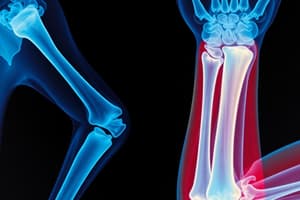Podcast
Questions and Answers
For an AP projection of the upright humerus, the upper medial border of the image receptor (IR) should be placed how far above the level of the humeral head?
For an AP projection of the upright humerus, the upper medial border of the image receptor (IR) should be placed how far above the level of the humeral head?
- 1.5 inches (correct)
- 0.5 inches
- 1 inch
- 2 inches
In an upright lateral projection of the humerus, what positioning adjustment ensures a true lateral image?
In an upright lateral projection of the humerus, what positioning adjustment ensures a true lateral image?
- Externally rotating the arm.
- Placing the anterior hand on the hip after flexing the elbow 45 degrees.
- Superimposing the humeral epicondyles. (correct)
- Aligning the coronal plane parallel to the IR.
What is the correct central ray (CR) angulation for an AP projection of the recumbent humerus?
What is the correct central ray (CR) angulation for an AP projection of the recumbent humerus?
- 5 degrees cephalad.
- 10 degrees caudad.
- 15 degrees cephalad.
- Perpendicular to the midportion of the humerus. (correct)
During a lateral projection of the recumbent humerus (lateromedial), how should the forearm typically be positioned to ensure the epicondyles are properly aligned?
During a lateral projection of the recumbent humerus (lateromedial), how should the forearm typically be positioned to ensure the epicondyles are properly aligned?
What is the primary indicator of correct positioning when evaluating an AP humerus radiograph?
What is the primary indicator of correct positioning when evaluating an AP humerus radiograph?
In a lateral recumbent projection focusing on the distal humerus, how is the central ray (CR) typically directed?
In a lateral recumbent projection focusing on the distal humerus, how is the central ray (CR) typically directed?
For a patient with a suspected humeral fracture, what modification to the standard lateral projection might be necessary, and why?
For a patient with a suspected humeral fracture, what modification to the standard lateral projection might be necessary, and why?
On a properly positioned lateral humerus radiograph, which of the following structures should be visible in profile on the medial aspect?
On a properly positioned lateral humerus radiograph, which of the following structures should be visible in profile on the medial aspect?
Flashcards
AP Projection Upright Humerus
AP Projection Upright Humerus
X-ray technique for examining the humerus in an upright position.
CR Positioning for AP Projection
CR Positioning for AP Projection
Central Ray (CR) is perpendicular to the midportion of the humerus and center of the IR.
Lateral Projection Upright Humerus
Lateral Projection Upright Humerus
X-ray technique for examining the humerus laterally in an upright position.
Superimposed Epicondyles
Superimposed Epicondyles
Signup and view all the flashcards
AP Projection Recumbent Humerus
AP Projection Recumbent Humerus
Signup and view all the flashcards
Lateral Projection Lateromedial Recumbent
Lateral Projection Lateromedial Recumbent
Signup and view all the flashcards
CR Positioning for Recumbent Humerus
CR Positioning for Recumbent Humerus
Signup and view all the flashcards
Lateral Recumbent Projection
Lateral Recumbent Projection
Signup and view all the flashcards
Study Notes
AP Projection Upright Humerus
- Patient Position: Seated or standing, facing the X-ray tube.
- Part Position: Adjust the image receptor (IR) so the upper medial border is 1.5 inches above the humeral head. Abduct the arm slightly, and supinate the hand. Ensure a coronal plane through the epicondyles is parallel to the IR.
- Central Ray (CR): Perpendicular to the mid-humerus and center of the IR.
- Collimation: 2 inches distal to the elbow, superior to the shoulder, and 1 inch on all sides.
- Structures Shown: Entire humerus length; accuracy is assessed by the epicondyles.
- Evaluation Criteria: Elbow and shoulder are visible, but potentially distorted. No rotation of the humeral epicondyles. Humeral head and greater trochanter are in profile view.
Lateral Projection Upright Humerus
- Part Position: Place the top of the IR approximately 1.5 inches above the humeral head. Internally rotate the arm (unless contraindicated due to fracture), flex the elbow ~90°, and position the patient's anterior hand on the hip. Ensure a coronal plane through the epicondyles is perpendicular to the IR. A medico-lateral projection might be easier for a broken humerus.
- CR: Perpendicular to the mid-humerus and center of the IR.
- Structures Shown: Entire humerus length. A true lateral view is confirmed by superimposed epicondyles.
- Evaluation Criteria: Superimposed humeral epicondyles; lesser tubercle in profile (medial aspect); greater tubercle superimposed over the humeral head.
AP Projection Recumbent Humerus
- Part Position: Place the upper margin of the IR 1.5 inches above the humeral head. Supinate the hand, extend the elbow, and rotate the extremity to align the epicondyles parallel to the IR plane.
- CR: Perpendicular to the mid-humerus and center of the IR.
Lateral Projection Lateromedial Recumbent Humerus
- Part Position: IR top margin 1.5 inches above the humeral head. Rotate the forearm medially to position the epicondyles perpendicular to the IR, resting the posterior aspect of the hand on the patient's side. This positioning avoids elbow flexion and maintains lateral epicondyle position.
- Note: No specific CR information is provided and no images are described in this projection type.
Lateral Projection Lateromedial Recumbent and Lateral Recumbent
- Patient Position: Recumbent (lying down).
- Part Placement (General): IR close to the axilla, with the humerus centered in relation to the IR.
- CR (Recumbent): Horizontal and perpendicular to the mid-humerus, centered on the IR.
- CR (Lateral Recumbent): Directed to the center of the IR, exposing only the distal humerus.
Studying That Suits You
Use AI to generate personalized quizzes and flashcards to suit your learning preferences.
Description
Learn about radiographic positioning for AP and lateral projections of the humerus. This includes patient and part positioning, central ray, collimation, and evaluation criteria. Covers proper techniques to visualize the entire humerus.




